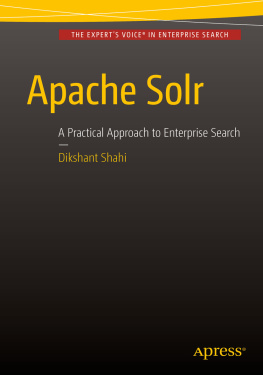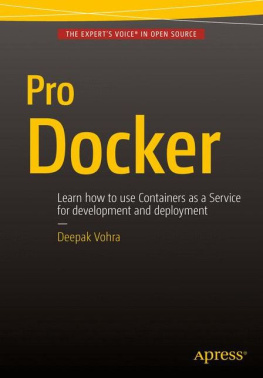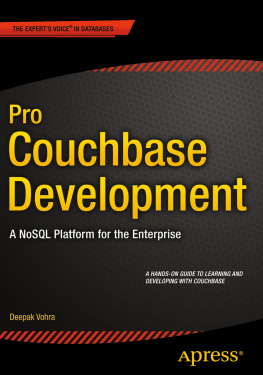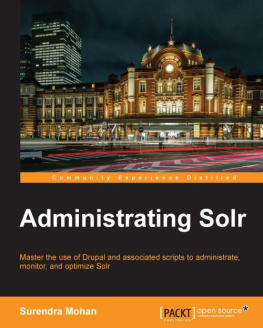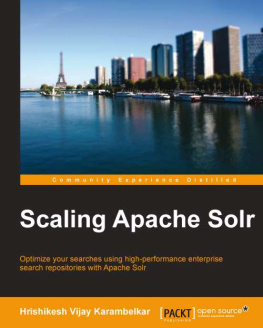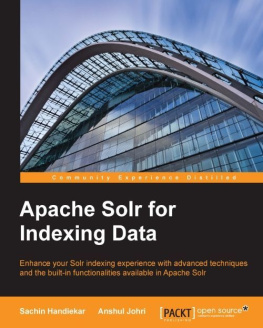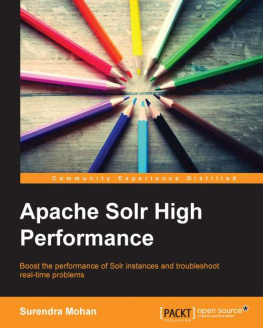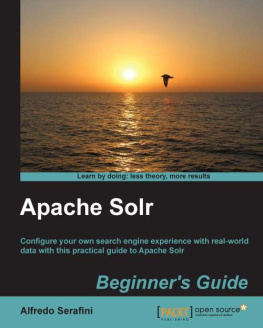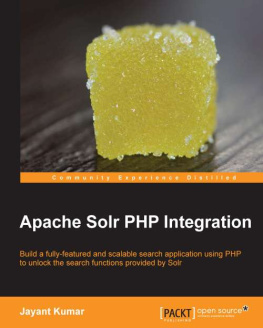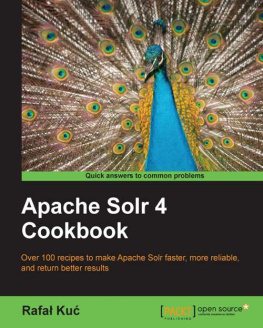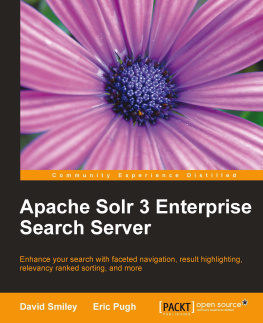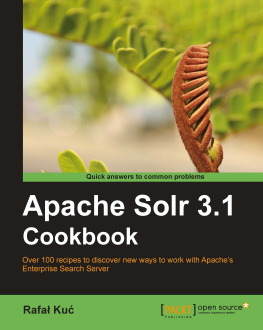Shahi - Apache Solr
Here you can read online Shahi - Apache Solr full text of the book (entire story) in english for free. Download pdf and epub, get meaning, cover and reviews about this ebook. City: Berkeley;CA, year: 2016, publisher: Apress, genre: Home and family. Description of the work, (preface) as well as reviews are available. Best literature library LitArk.com created for fans of good reading and offers a wide selection of genres:
Romance novel
Science fiction
Adventure
Detective
Science
History
Home and family
Prose
Art
Politics
Computer
Non-fiction
Religion
Business
Children
Humor
Choose a favorite category and find really read worthwhile books. Enjoy immersion in the world of imagination, feel the emotions of the characters or learn something new for yourself, make an fascinating discovery.
- Book:Apache Solr
- Author:
- Publisher:Apress
- Genre:
- Year:2016
- City:Berkeley;CA
- Rating:4 / 5
- Favourites:Add to favourites
- Your mark:
- 80
- 1
- 2
- 3
- 4
- 5
Apache Solr: summary, description and annotation
We offer to read an annotation, description, summary or preface (depends on what the author of the book "Apache Solr" wrote himself). If you haven't found the necessary information about the book — write in the comments, we will try to find it.
Shahi: author's other books
Who wrote Apache Solr? Find out the surname, the name of the author of the book and a list of all author's works by series.
Apache Solr — read online for free the complete book (whole text) full work
Below is the text of the book, divided by pages. System saving the place of the last page read, allows you to conveniently read the book "Apache Solr" online for free, without having to search again every time where you left off. Put a bookmark, and you can go to the page where you finished reading at any time.
Font size:
Interval:
Bookmark:
- Important features of Solr
- Important components of Solr
- Use of Solr beyond its search engine capabilities
- Comparison of Solr with other solutions
- Technologies used in Solrs ecosystem
- Inverted index : Lucene builds an inverted index of the documents that you add to Solr, and at query time it searches the index for matching documents. You can think of an inverted index as similar to the index at the end of this book.
- Vector space model : By default, Lucene uses the vector space model (VSM) along with the Boolean model to determine the relevance of a document with respect to a user query. In a nutshell, the Boolean model approves, and the VSM ranks.
- Config-based : solrconfig.xml and schema.xml are the two primary configuration files of Solr. The schema.xml file primarily defines the fields of your schema and the behavior of those fields (how the text will be tokenized while indexing and querying). Almost everything else goes in solrconfig.xml . You can also go schemaless and let Solr create fields automatically while indexing the data. The configurations can be edited manually or modified dynamically by calling the respective APIs. As of Solr 5.0, you can even upload JAR files through an API call.
- Analysis chain : Your search query and the documents being indexed go through a chain of analyzers and tokenizers (the output of one tokenizer is fed to another in the chain). The output of the last tokenizer is the term that is indexed and matched against.
- Java : Solr and Lucene are written in Java. Solr 5.0 requires Java 7+ to run. To customize any feature of Solr, you need to extend the appropriate Java class.
- SolrJ : Solr bundles a Java client library that can be used for indexing documents and querying for results. Libraries are also available for other languages such as Perl and Python.
- Lucene : Solr uses the Lucene search library at its core and wraps it to add features and expose it as a RESTful service that can be accessed over HTTP. Development of Solr and Lucene merged in March 2010, and both the code bases reside in the same trunk in Apache Subversion (SVN); hence you are sure to get all the latest Lucene features in your latest Solr release.
- Highly scalable and fault-tolerant : You can add or remove computing capacity to Solr, just by adding or removing replicas of your instance as needed. SolrCloud even abstracts your application from knowing how the data is distributed and saves you from getting into further nuances such as load balancing and sharding. Data indexed to Solr can be replicated among multiple instances; so even if one instance goes down, the data will still be accessible.
- Enterprise ready : Solr is well proven and trusted by many leading organizations for their search requirements and for handling extensive loads. It can be deployed in stand-alone, traditional distributed architecture or in cloud mode based on the need of the organization, big or small.
- Full-text search : As Solr is built on top of Lucene, it provides all the matching capabilities needed including token, phrases, fuzzy, wildcard, spell-check, and autocomplete.
- RESTful XML/JSON over HTTP : Solr is exposed as a RESTful web service and can be accessed over HTTP. Data can be exchanged in XML, JSON, CSV, and binary format.
Font size:
Interval:
Bookmark:
Similar books «Apache Solr»
Look at similar books to Apache Solr. We have selected literature similar in name and meaning in the hope of providing readers with more options to find new, interesting, not yet read works.
Discussion, reviews of the book Apache Solr and just readers' own opinions. Leave your comments, write what you think about the work, its meaning or the main characters. Specify what exactly you liked and what you didn't like, and why you think so.

